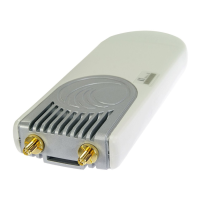PAGE 1-8
Radar avoidance
In regions where protection of radars is part of the local regulations, ePMP must detect interference
from radar-like systems and avoid co-channel operation with these systems.
To meet this requirement, ePMP implements the following features:
The equipment can only transmit on available channels, of which there are none at initial power up.
The radar detection algorithm will always scan a usable channel for 60 seconds for radar
interference before making the channel an available channel.
This compulsory channel scan will mean that there is at least 60 seconds service outage every time
radar is detected and that the installation time is extended by at least 60 seconds even if there is
found to be no radar on the channel
There is a secondary requirement for bands requiring radar avoidance. Regulators have mandated that
products provide a uniform loading of the spectrum across all devices. In general, this prevents
operation with fixed frequency allocations. However:
ETSI regulations do allow frequency planning of networks (as that has the same effect of spreading
the load across the spectrum).
The FCC does allow channels to be avoided if there is actually interference on them.
Note When operating in a region which requires DFS, ensure that the AP is configured
with alternate frequencies and that the SM is configured to scan for these frequencies
to avoid long outages.
Encryption
ePMP supports optional encryption for data transmitted over the wireless link. The encryption algorithm
used is the Advanced Encryption Standard (AES) with 128-bit key size. AES is a symmetric encryption
algorithm approved by U.S. Government organizations (and others) to protect sensitive information.
Country codes
Some aspects of wireless operation are controlled, enforced or restricted according to a country code.
ePMP country codes represent individual countries (for example Denmark) or regulatory regions (for
example FCC or ETSI).
Country codes affect the following aspects of wireless operation:
Maximum transmit power
Radar avoidance (future release)
Frequency range

